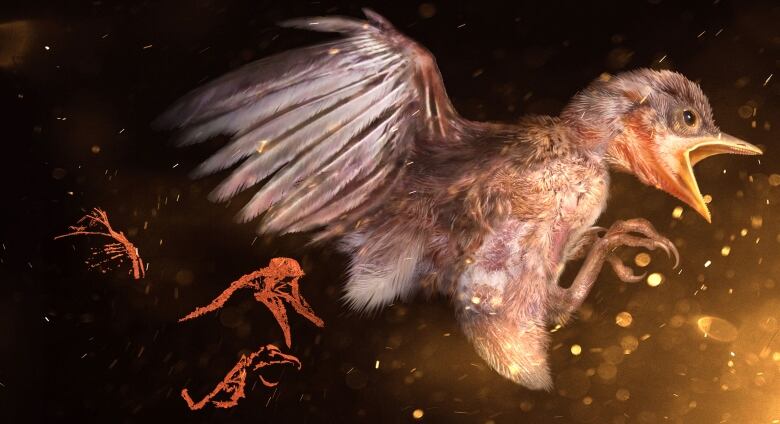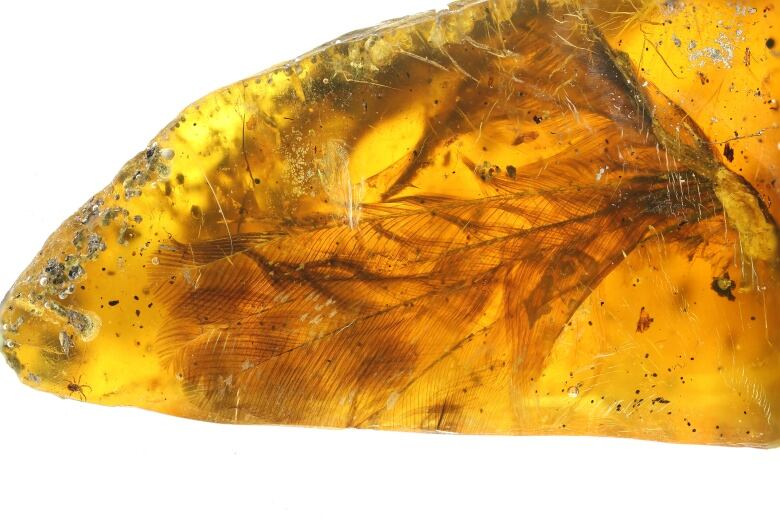Scientists find baby bird trapped in 99-million-year-old amber
Hatchling is one of the most detailed specimens from the Cretaceous period

The remains of a prehistoricbaby birdhave been found preserved in a 99-million-year-old piece of amber in Myanmar.
It's one of the most detailed specimens ever discovered complete with scales, feathers and claws in a regionknown for its deposits from the Cretaceous period, which lasted from 145.5 to 65.5 million years ago.
We've had more complete specimens ...but never with this level of detail.- Ryan McKellar, Royal Saskatchewan Museum
"We've had more complete specimens, where you get more of the skeleton preserved, from compression fossils, but never with this level of detail," RyanMcKellar,curator of invertebratepaleontologyat theRoyal Saskatchewan Museum, told CBC News.
It even has other remnantsof prehistoric life,like insects and mites, trapped inside.
"It's like a little diorama," saidMcKellar.

The miner who collected the specimen at a commercial amber mine in 2014thought it was a lizard claw, but the director of theHupogeAmber Museum was sure it was the foot of a small bird.
That's how the specimen nicknamed "Belone" (a local term for an amber-coloured bird called the Oriental skylark) ended up with paleontologistLidaXing, ofthe China University of Geosciences.
Using a CT scan, Xing and his team found hidden structures within that revealed the skull and even vertebrae. Using that imagery, and without destroying the sample, they were able to create a complete 3D model of all the bird, which they published in apaperin GondwanaResearch.

'Evolutionary holdover'
Belone belongs to a group of birds called the Enantiornithes, which differ from their modern-day peers in many ways.This was an extraordinary bird,McKellarsaid.
"They're coming out of the egg with feathers on and theability to fly within the first day or two, with claws that help them clamber up the sides of trees pretty quickly," McKellarsaid.

Beloneis believed to have been preserved in the amber when it was just days or weeks old.
As for its feathers, the bird had different kinds: some that paleontologists have seen on dinosaurs, but others that are closer to modern-day birds. This, McKellar said,was one of the most surprising and rewarding finds.
Belone lived during a period when triceratops roamed the land alongwith velociraptors and the Albertosaurus. Enantiornitheswasa group of birds that was amongthe mostabundantand diverse known from the Mesozoic era. However, they went extinct at the end of the Cretaceous period.
"We have a sort of evolutionary holdover from this particular specimen," he said.
- Scientists discover feathered dinosaur provides more clues to evolution of birds
- World's best-preserved armoured dinosaur revealed in all its bumpy glory
- ROM scientists name new dinosaur species after Ghostbusters villain
McKellar, along withXing, were also lead researchers of a find announced last December of adinosaur feather trapped in amberfrom the same location.
The area has been mined for amber for the past 2,000 years and is one of the richest sites of its kind, which is why there have been quite a few discoveriesof late. However, not all prehistoric finds make their way into museums. Hehopes that will change as people recognize the significance of such discoveries can make to better understanding Earth's prehistoric past.
"The more of these samples we get, the better or more complete picture we get," said McKellar.












_(720p).jpg)


 OFFICIAL HD MUSIC VIDEO.jpg)
.jpg)



























































































